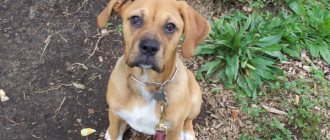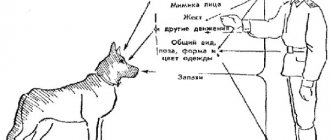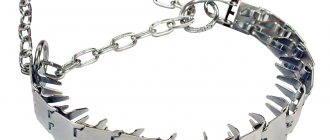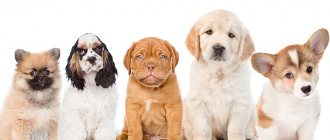What to consider when choosing
Harnesses can be used for various purposes: for regular walks, sports activities or official work. In winter, they can also be used traditionally - to harness a dog to a sled and transport loads with it. Such events can be turned into an interesting game - a pet pushing a child on a sleigh will get the physical exercise he needs and give the family a lot of positive emotions. To know how to choose the right harness for your dog, focus on the following indicators:
- Material. Manufacturers use durable, soft and wear-resistant materials. At the same time, not all companies treat their work responsibly. Please note that during walks a lot of dirt will appear, so the harness should be easy to wash. It is best to make a choice with a minimum amount of knowledge about all the available varieties. For dogs of miniature breeds, light woven products are suitable, while for a wolfhound the best solution would be a heavy leather harness;
- Zas
How to choose the right harness
When choosing ammunition, you need to pay attention to every little detail and weigh all the details. Almost everything plays an important role: the weight of the product, the size and breed of the dog, the material and workmanship.
How to choose the size
Any clothing and accessories must fit. You need to know exactly how to choose the right size harness for your dog. To do this, you need to take measurements from the dog. Using a measuring tape, measure the length of the body, the height of the paws, the girth of the neck, chest and hips. In accordance with these measurements, you need to select a model, and then try it on an animal. Trying should be done directly at the pet store so as not to make a mistake with the choice.
How to choose for the breed
Depending on the dog’s body composition and its breed, you need to choose different harnesses.
- A simple model is perfect for dogs with thick necks: pugs and French bulldogs. It is also worn by larger dogs, for example, dachshund, boxer or staff (Staffordshire terrier).
- Equipment made of velor or nylon is intended for small decorative dogs: Chihuahuas, toy terriers, Yorkies.
- The largest sizes of ammunition are intended for large breeds: huskies, Rottweilers, Dobermans, shepherds.
Huskies are very active and lively dogs, so a harness helps them move freely.
Note! The larger the dog, the stronger the harness should be. For small pets, light ammunition made from thin materials is sufficient.
How to take measurements
What material is better to buy a harness from?
For large dogs, you will need harnesses made of leather or leather substitute. Sturdy parts will support the weight of the dog. But it is better to give preference to softer materials. There are combined options made of leather and nylon.
For small dogs, it is best to offer velor or nylon harnesses. It will be difficult for them to carry heavy leather equipment.
What are the types?
A walking harness is the most common accessory option, often made of thin material, such as nylon or leather. A riding harness for dogs is one of the very first types of harnesses. This is a more complex system of belts and pieces of fabric, involving the assembly of dogs in one chain for sports competitions or harness racing. The materials for such harnesses are often canvas and nylon. The vast majority of these accessories are intended for large sled dogs such as huskies and malamutes.
A weighted harness is used to train the physical qualities of dogs when it is necessary to better develop them for competitions, and to fix the position of injured dogs and animals after operations. A weighted harness prevents dogs from jumping high and forces them to stay closer to the ground. This is suitable for large and medium breeds, while it can cause injury in small ones.
A harness-vest is a more advanced version of a harness that looks like an element of outerwear. Designed for small and medium-sized short-haired and hairless breeds, helping to insulate dogs in the cold season. Sometimes used as a fixative for medical purposes. The guard harness has increased strength. It consists of 2 or more layers of material, reinforced with stitched belts and metal rings. Used for dogs in protected areas to prevent them from running away.
A puppy harness is a lighter version of a harness designed for walking puppies . The start of using a harness is different for different breeds, but not earlier than six months of age, since a puppy’s muscles and bones are not yet as strong as those of an adult dog.
What is a harness, its types
Special equipment for dogs, which gradually replaces the collar, is usually called a harness. Its difference is that it is attached not to the neck, but to the body of the animal. Most often it is made of leather or strong material in the form of belts that encircle the chest and body of the dog, connecting between the front legs along the ridge.
Experienced dog breeders claim that this equipment is more practical and safe for the pet, since when the leash is sharply pulled, the animal does not experience pain in the neck, which is fraught with wearing a collar. You can see what the harness looks like in the photo below.
The classification of harnesses is impressive; their main difference is what purpose the equipment will serve and the size of the pet itself.
Let's look at the types of harnesses:
- Riding harnesses for dogs. Most often they can be found on pets that participate in sports competitions, in particular during sled dog racing. The towing type of this harness requires increased strength of the belts. The preferred material is nylon or canvas. The harness is perfect for malamutes and huskies.
- Harness with weights . They are used to strengthen the dog’s muscle mass, and are especially useful in case of broken paws in the animal. Special pockets on the straps allow you to regulate your pet's physical activity. Using this type of harness requires monitoring the dog's training, in particular jumping should be avoided. As an alternative, it is permissible to use a collar with a load, most often small. Its use is necessary to prepare a young pet for more serious weights. A collar with weights is suitable for large and medium-sized dog breeds (for example, Jack Russell Terrier); for small breeds it is better to avoid such equipment, as it can injure the pet’s cervical region.
- Harness-vest . An original accessory for a pet with short fur, which will help to further insulate it. Ideal for small pets that do not want strain on their necks, such as Pomeranians or Chihuahuas. Additionally, this type is used for medical purposes; the better structure of the equipment covers most of the dog’s body, and the attachment located near the hind legs allows the load to be transferred to the forelimbs.
- Walking harness. Most often it is made of thin material, such as leather or nylon. Constant use assumes that such a collar for dogs through the paws will “fit according to the figure” and will not interfere with the animal in any way.
- Guardhouse . The most durable option of all. Usually these are two-layer or more harnesses, with stitched straps and welded rings, with the help of which the dog is tied to the checkpoint. Strong material will not allow the animal to fall off.
- Harness for puppies. Lightweight and soft option that reduces the load on the spine. You should start dressing after six months of age, when the animal’s skeleton is fully formed and the muscles are sufficiently strengthened. Remember that an untimely harness can significantly damage the health of your little pet.
What to consider when choosing
For dogs, make sure it is easy enough to put on and take off. Several fasteners will increase its resistance to tearing and make it more comfortable for your pet - you can easily adjust its size so that your dog does not feel discomfort;
- Fit to the body. Ideally, the straps are attached tightly to the body so that they do not move when moving. At the same time, the accessory should not restrict the pet’s movements; excessive tension will make walking and running difficult, and can cause inflammation and hair loss in the contact area;
- Matching sizes. Knowing how a harness should sit on a dog will help you make the right choice. First of all, you need to take into account that its upper part must fully correspond to the width of the back (measurement is carried out with a centimeter along the body, taking into account thick fur).
The main requirement for the product is convenience for daily use, but the owner must take into account that it should not be used daily. The harness is considered as a tool for training and special physical training of the pet, but too frequent use can damage the coat. After a walk or completing a required task, it is better to remove it; leaving the dog in a harness at home unattended is unacceptable, as this can lead to undesirable consequences.
How should a harness fit properly on a dog?
A properly selected harness is extremely important for the fruitful work of a sled dog. We're talking about the classic x-back riding harness.
The correct position of the harness on the dog's body can only be assessed when it is under load, i.e. when the dog leans heavily on the chest straps! ! !
When evaluating a harness, you must first pay attention to the position of 4 critical points:
1) the upper connection of the chest straps should be at the withers, but not at the shoulder blades;
2) the lower connection of the chest straps should be on the keel (the protruding bone on the chest), but not on the throat;
3) the connection on the side of the traction straps coming from the withers and from the sternum , under load, should be no lower than the last rib of the dog;
4) the end of the harness (the end of the harness is the beginning of the loop) under load should be at the base of the tail, but not behind the tail.
And now each point in more detail...
Let's start with the neck.
The straps are positioned in such a way that the neck sits exactly at the base of the neck, bypassing the bones and their joints, ensuring free breathing and movement. The harness should fit very tightly, like a glove. IMPORTANT! When putting on the neckline, you need to take the dog by the skin and pull out all the formed folds of neck skin from under the straps so that the harness fits tightly and does not move out. The upper connection of the slings should lie directly at the base of the withers (you can feel a small dimple in this place with your fingers) in front of the spinous edges of the shoulder blades, but in no case on them - the movement of the forelimbs and their free extension directly depend on this, the straps should not touch the shoulder blades . The lower connection lies on the forebreast (the protruding bone on the chest - the keel, easily located with a finger) or a couple of centimeters higher, so as to close it. The neck should fit in such a way that 2 fingers fit through the lower part. If it’s longer, the harness will dangle and shake, and in combination with an excessively long chest strap, it will slide down and put pressure on the armpits.
The connection of the upper straps going from the neck to the lower straps must be no lower than the last rib of the dog - otherwise the stomach is pinched and the dog cannot move and breathe normally!
The lower straps are the longest, running along the lower edge of the costal arch. The back part of the strap is connected clearly at the root of the tail so that the slings pass under and next to the pelvic bones (the upper bones of the pelvis, easily palpable in a dog), but in no case not on them, otherwise the dog will experience significant discomfort, and this will last for a long time will disable it and discourage any desire to work. It is better to let the harness be a little longer than shorter.
The cross of the back straps, the so-called X (x), is made to evenly distribute the load on the back; its cross should be in the middle of the lower back. The mlocks fit into the lower diamond of the cross with a correctly selected harness.
How to measure a dog for a harness
An inexperienced owner does not know how to determine the size of a dog harness. This task can be overwhelming, especially if you go to a large pet store. Sellers can give certain advice, but it is better for the potential buyer to know how to choose the right size harness for a dog. This is especially important for those who make purchases online. To avoid mistakes, you need to take the following measurements using a centimeter:
For representatives of medium and large breeds, a good choice would be equipment made from woven braid or leather. The product must be equipped with steel carabiners and solid rings. This requirement is also true for dogs of small working or hunting breeds - miniature schnauzers, dachshunds, and others. For representatives of decorative breeds, appearance and comfort are more important, so nylon or velor models are the best choice here.
How to measure a dog correctly?
You will need a measuring tape, a notepad and patience. The parameters are as follows:
- Dog's neck circumference. Measurements are taken in the place where the collar fits comfortably, at the base of the neck. In front it is the keel, the bone protruding forward under the neck, in the back it is the edge of the shoulder blades, located closest to the back of the head.
- Chest circumference. Measured at the widest point behind the front legs. You need to add 1.5-2 cm to the number on the centimeter for a loose fit.
- Back length. The beginning is at the base of the withers, the end is at the base of the tail.
To make a purchase, you can use the size table provided on the store’s website; you should not focus only on the dog’s breed, since the dimensions of your pet may differ from the standard ones.
Important! When taking measurements yourself, you should press the centimeter firmly against the dog’s skin, pressing down the fur. Necessary increases should be made to the measurements taken later.
Important! Pay special attention to the harness fittings. For representatives of large and medium-sized breeds, the carbines must be metal, the rings must be solid. For small and decorative breeds, plastic ones may be sufficient.
When can you use ammunition with weights?
Pedigree: food for dogs and puppies of small and large breeds
Dogs of fighting breeds begin to be trained using weighted equipment from the age of one year. It is generally accepted that for raising representatives of non-fighting breeds who have not yet reached 1.5 years of age, the use of weights is not permissible. If the dog is predisposed to joint diseases, they are not used at all.
Alternating days of exercise with days of rest, the dog breeder makes notes in a specially kept notebook. Records are kept in pen and are issued in the form of mini-reports on the pet’s health status and changes that have occurred in the dog’s body during training.
Dog equipment with weights
During the first two weeks, the dog is put on a harness with empty pockets. Then the pockets are loaded for a short time with a small amount of weights, the total weight of which is from 50 to 100 g. Weekly, the load is increased by 50–100 g, first of all by weighting the side pockets, and then those located on the back. The maximum weight of loads placed on a young dog should not exceed 4 kg.
Equipment with weights is put on the dog for 30 minutes after warming up, consisting of trotting and jumping. After 5 training days, the dog is given 2 days to rest. During this time, the dog is walked without weights and is not forced to run, jump or overcome obstacles.
Note! Carrying weights around haphazardly can lead to depressing consequences - the animal’s back will bend, the heart will weaken, and the limbs will become twisted.
How to choose the right harness?
Size
Measurements for choosing a harness.
For comfortable wearing, the harness must be correctly selected according to the size of the dog. There are size tables and patterns to make selection easier. To use the table, you must take several measurements from your pet:
- Main measurement: from the bones of the withers to the base of the tail, the length of the back is measured.
- Bust: Measured at the widest point just behind the elbows. 1 cm is added to the result for small breeds, 2 cm for large breeds.
- The circumference of the neck is where the collar should be.
Measurements to determine the size of a riding harness are taken differently due to the design features of the equipment. The sled harness requires the following dog measurements:
- the distance between the beginning of the sternum and the withers;
- sternum length;
- the distance from the end of the sternum to the base of the tail.
A properly sized harness does not hang loose on the dog’s body, but does not put pressure anywhere. Your palm should fit under the straps.
Types of harnesses
There are different types of harnesses in terms of design and purpose:
- recreational and for amateur sports;
- training, with weights;
- for official and follow-up work;
- for guide dogs:
- cargo, for transporting heavy loads;
- riding;
- pack
Walking harness.
The last four varieties are best made to order in accordance with the dimensions and body features of a particular dog.
For service work and for working with cargo, durable harnesses made of canvas, synthetic braid or leather, with wide belts, are used. Rings and buckles on this equipment should only be made of steel, preferably cast, or in extreme cases, securely welded. In this case, the price is justified by reliability. A design in which the animal has to be literally squeezed piece by piece into the harness system is undesirable. There may be a few more fasteners, but the harness should be such that it can be worn as comfortably as possible for the dog. This applies to all types of harnesses. Make sure that the rivets do not catch the wool, so that the buckles and fasteners do not put pressure on the body and cause discomfort. While working, the animal should not be disturbed by anything.
For training harnesses, it is important that the load is distributed as evenly as possible. It is better to choose harnesses that have several pockets for weight: this will help regulate the load more effectively. These harnesses are made from durable thick leather, synthetic materials and canvas.
Walking harnesses are the most common and popular. They may vary in design. Choosing the best and most comfortable harness will be easier if you consult with owners of dogs of the same breed as your pet. In all cases, you need to pay attention to the integrity of the rings into which the leash carabiner is fastened, and to the reliability of the fasteners. For small decorative breeds, harness clasps can be made of plastic, but for medium and large dogs - only metal.
In terms of choosing a harness model, it makes little sense for decorative dogs to pay attention to the reliability of the design. The comfort of the equipment is of greater importance: softness of the material, ease of donning. Harnesses for small dogs are often combined with insulating vests and blankets. In the assortment of pet stores, decorative harnesses with all kinds of decorations make up one of the largest sections. You can make such ammunition with your own hands, giving scope to imagination and creativity.
Materials
Synthetic harness.
This is an important criterion for choosing a harness for medium and large breeds.
The most practical are synthetic materials. They do not get wet, are easily washed off from dirt, and are strong and durable. Cheaper options are made from thick canvas tape. Tarpaulin is durable, but wears out faster than synthetic materials. It gets wet, doesn’t wash well, and takes a long time to dry. But canvas harnesses are the most inexpensive. The harnesses made of leather are beautiful. But the skin has an unpleasant property: it gets wet. Skin that gets wet in the rain or in a body of water becomes more elastic and stretches. And when it dries, it becomes hard and can crack. Leather products are beautiful and expensive, but not very practical.
It is best to select a harness using fittings, and not from photos. Only by putting a piece of equipment on your dog will you be able to see whether this particular design is suitable for your dog, or whether it is better to choose something else. Many pet stores allow fittings.
Video. How to choose a dog harness
Dog Harness Size Chart
Size Belt width in mm Chest coverage from max to min (cm) Dog breeds XL2513090 Central Asian Shepherd, Dogue de Bordeaux, Caucasian Shepherd L2510070 Doberman, German Shepherd, Giant Schnauzer M258060 Labrador, Golden Retriever, Setter X207050 Spaniel, Beagle, Miniature Schnauzer cerXS155540pug, West Highland white terrier, small poodleXXS154533Toy terrier, miniature pinscher , Yorkshire TerrierWhat is a dog harness
A harness (may also be called a harness) is a piece of dog equipment necessary to control an animal during a walk, develop its strength and endurance, and protect it during transportation in a car or after veterinary treatment. Typically, such products are made of fabric or leather belts that cover the chest and part of the pet’s back. Harnesses are a convenient alternative to classic collars, since the attachment point of the leash is not on the neck, but on the croup or withers, allowing the animal to breathe more freely and move more actively in space.
Depending on the specialization of a particular dog and the purpose of using the harness, today you can purchase both regular walking versions and specialized riding or service ones, but in any case, the product must fit perfectly on the animal’s body, taking into account its physical strength and body structure.
Did you know? Thanks to their well-developed sense of smell, dogs are able to identify certain human diseases by the smell emanating from a person. According to research by American scientists, approximately 10% of all pets can warn their owner about an upcoming epileptic attack, allowing the owner to properly prepare for it.
How to put a harness on a dog, step by step guide
An owner who has only recently acquired a pet may face categorical rejection. He will resist in every possible way, trying to free himself from the tight harness. This is completely natural, because the dog may not immediately appreciate all its advantages. But if you do the right thing, then over time he will rejoice at the sight of the harness in your hands, because for him it will become a symbol of a walk and a fun time.
How to measure a dog for a harness Knowing how to put a harness on a dog can waste a lot of time; some owners, after several unsuccessful attempts, generally consider it as a useless accessory, depriving them of all the benefits that it can provide. To put it on quickly, use the following guide:
- If your pet is disobedient and refuses to obey, secure it between your legs in the back area.
- Before putting a harness on your dog for the first time, distract him with a favorite treat or toy. If even at this stage you are unable to achieve the required results, then conduct several exercises for endurance;
- Place the ring-shaped part of the closed-type harness around the chest in front of the paws; its dimensions may vary depending on the design of the accessory;
- Next, position the strap along the top of the case to the desired position, thereby limiting the space between the jumper and the closed circle. The right paw is threaded into the area between the closed circle and the strap;
- The jumper passes through the surface of the chest, a strap is put on the right side, after which the loose part must be threaded through the armpit of the left paw. Next, all that remains is to fasten all the belts.
After you manage to tie the dog harness, release it, adjust it and make sure that the accessory does not choke your pet and fits firmly enough to his body. The last step is to check the fastened parts. Even using step-by-step instructions on how to put a harness on a dog, you may encounter certain difficulties. Take your time, perform all the steps sequentially, and do not hesitate to ask questions to familiar dog breeders or store sellers. Harnesses may vary in design, but the principles remain the same.
So how to properly put a harness on a dog?
At the first time, the dog may resist, which is absolutely normal, because it needs to be accustomed to any innovation gradually. But by showing patience, endurance, using game elements and positive reinforcement, you will quickly achieve the desired result.
So, let’s put on the harness, step by step guide:
- Introduce the dog to a new object, let it sniff, examine, while it is better to praise and calm the animal.
- If your dog resists, place him between your legs, squeezing him at the waist, while distracting him with a toy or treat. It is important here not to scare, not to form a negative attitude towards ammunition.
- Place the front section around your neck, then pass the bottom strap between the front legs and fasten the side buckles.
- Check to see if the harness fits your dog's body comfortably. To do this, try to place your palm under the straps. If it passes freely, congratulations, you did everything right!
If the design of your harness differs from that described, simply calmly and consistently perform all the steps, encouraging your pet at each stage and treating your pet with a treat. After a few repetitions, the harness will become a symbol of a long walk for your dog, and the process of putting it on will become the most joyful event of the day.
For large breeds
The harness for oversized large dogs is designed to work with heavy loads. Usually they try to choose a wide leather model that can withstand the significant weight of the animal, multiplied by the speed of its jerk.
Important! Departmental nurseries often use sets with molded buckles - a large animal at the peak of activity can loosen a simple harness or bend a thin ring, from which the belt or leash will immediately fall off. Such a device costs more, but it also has a much greater resource.
For ease of walking, these devices come complete with structures that allow you to hold the leash freely and not tightly. Most often this is a carabiner or a brace connected to a ring located on top of a strip running across the back.
Convenient, especially if the dog is relatively calm and not prone to aggression. But for walks with representatives of fighting or service breeds, such a product is unlikely to be suitable.
For small breeds
Dwarf dachshunds, Spitz dogs and animals of similar size are the “clientele” of mini-harnesses.
In appearance, they are the same as devices for large dogs, only adjusted for size. There are perhaps more materials and colors in this segment than in any other.
Having put such a kit on your mini-dog, you can be sure that he will not go anywhere. In addition to the traditional leash and fastenings, these sets are often equipped with handles firmly sewn to the back strap. That is, an animal that has become excited can simply be picked up and carried away from a dangerous place.
For puppies
The youngest individuals require a special approach. The bone structure of babies is not yet formed, and a regular harness can disrupt the development of paws and muscles (especially in the sternum area).
Did you know? Dogs detect sounds with a frequency of up to 35 kHz, and the human ear works with ranges up to 20.
To avoid such difficulties, puppy kits are used from 6-9 months. The exact figure depends on the breed, so it is worth consulting with your veterinarian.
These sets stand out right away - the strips are narrower, and their leather or nylon base is well lined with soft material (so that the “harness” does not dig into sensitive skin).
For exhibitions
Here it is important to consider not only functionality, but also design.
The decoration and fittings should emphasize the color and noble character of its wearer. This also applies to the color scheme.
Much depends on the owner. The fact is that in pursuit of show endurance, sometimes they resort to trickery, putting a deliberately uncomfortable set on the dog (believing that by taking a size smaller, it will be possible to control its behavior unnoticed by visitors). The result is microtrauma and stress, plus the risk of not qualifying for the next examinations.
Find out what grooming is, how to make a pattern for a dog's overalls, how to choose a clipper and a furminator for your pet.
The other extreme is comfortable, but too bright LED-type harnesses. The flickering lights will only irritate the dog, and he will most likely try to get rid of the source of discomfort.
Freight
Used for training four-legged athletes.
There are two types:
- Half-vests with side pockets in which cargo is placed (rounded stones or bags of sand).
- Standard products with an additional belt, on the edge of which there is a ring with a chain that covers the weighting material. Usually this role is played by a car tire.
The main task is to develop the main muscle groups. In order for the classes to bring only benefits, you will have to control their progress. Jumping and too sudden jerking while wearing a weight harness are contraindicated. Important! During training, make sure that the “weight” in the pockets does not scratch or clog the client’s side. It is better to put sharp or too heavy objects aside.
Vests
Ideal for winter walks for pets with short hair or fine lines.
It is preferable to take products with a fur lining of small thickness - after running around in a vest that is too thick, the dog may catch a cold.
For sledding breeds
A sled harness is only suitable for a hardy and “diversified” dog - a Malamute, Husky or Samoyed.
The design combines strength and comfort for the dog himself. It is sometimes difficult to select such a product, so the way out of the situation is by ordering such kits from craftsmen.
This entails some costs, but such custom tailoring for dogs takes into account all the characteristics of an individual animal. The materials used are durable and moisture-resistant nylon or canvas.
The device itself is also different - there are more belts, as well as fastening rings (which allows you to evenly distribute the load on the body).
Choosing a harness
Which harness to choose
Riding harness
sled harness - the design of the harness, the length of which ends at the base of the tail, is best suited for skijorring (towing a skier), bikejorring (towing a cyclist), scootering (towing a scooter), canicross (towing a runner) and mashinga (riding a sled of dogs harnessed in the sled).
The harness can be used both for competitions and for daily walking. The only drawback of a standard-length harness is that it is not advisable to use it for towing sleds, tires or other low-set loads. This is especially true for medium and large dogs, since in this case the pressure on the croup increases: first, the load goes along the line of the dog’s back, and, in the area of the croup, at an angle to the sled or tire; The greater the height of the dog at the withers, the greater the angle of break and, accordingly, the greater the pressure on the dog’s croup and hind limbs.
In the case of towing loads with small dogs, the bend angle tends to zero and a standard length harness can be used for all types of activities related to the use of dog draft power.
Long harness
The extended harness is an intermediate option between the riding and cargo harnesses. This modification is the best choice for those who are not going to seriously engage in sports, but plan to use it only occasionally to take the child on a sled or on country ski trips on weekends.
The difference from a standard-length harness is that the bend angle of the load is placed outside the dog’s body, due to which the pressure on the croup is so small that it can practically be neglected.
This design works well not only in the Sled Service, but also when training dogs for the Protective Guard Service.
Cargo harness
A cargo harness is a highly specialized version of a harness designed for power loads. The main application is competitions in the transportation of heavy objects (weightpulling). Can be used to develop the chest and form sculpted muscles. Indispensable when developing a classic show stance in a dog.
Disadvantage - it is not advisable to use it for training young people, since if the dog suddenly stops while moving, the crossbar can hit the hock joints. This can lead to stress and persistent resistance to the weight harness over a long period of time.
Rinat Khabibulin.
Types of harnesses
The modern market for accessories for dog breeders is very diverse and is represented by a large number of products of different types. They can be divided into groups according to size, type of materials used, and purpose. Some models are complemented by special pockets for cargo, fastening rings for harnesses or other elements that expand the functionality of the product. When you go to a pet supply store, you can find the following harnesses:
- Walking. The fastening ring on them is fixed in the withers area. They are well suited for daily walks, which is especially convenient with small pets. Products of larger sizes are equipped with additional belts;
- Towing. Their purpose is sports competitions. Such harnesses are worn on hyperactive dogs prone to non-stop forward movement. With their help, they train the chest muscles for German Shepherds and other breeds. I use it for them
If you go for a walk, do so only in comfort! How to choose a harness for a dog?
Collars are gradually losing their relevance, and they have been replaced by harnesses. I tell you in detail what to look for when choosing and how to determine that the device is chosen correctly.
The bow is in touch, and today, on behalf of all four-legged and barking animals, I want to tell you a secret: a harness is much more convenient than a collar, and we like it much more.
Believe it or not, it’s up to you, but I still recommend getting comfortable and learning how to choose the right harness for your dog.
Dog Harness Size Chart
bonds. If your dog requires increased physical activity, use weighted harnesses. Some models are complemented by weights sewn inside, others have pockets with metal bars with which the weight can be adjusted. Their use is advisable for strengthening muscle mass after fractures.
Pay attention to the article types of harnesses.
Progressive dog handlers never wear a harness for every walk and activity. The load should be uniform and appropriate. It is most convenient to train your pet at a very early age, at the same time as a collar, in which case you will need a miniature harness designed specifically for puppies. By putting it on your baby already at this stage, you can accustom him to the idea that a harness and other types of equipment are primarily associated with walks and having fun.
How to put a harness on a dog?
For inexperienced dog owners, this can be a problem. But don’t despair, there are several options for learning how to do it correctly!
- You can find video instructions on the Internet and choose the one that suits you and your pet.
- You can follow the step-by-step steps shown on the harness packaging.
- But it’s best to contact a specialist once, who will show you step by step how to put a harness on a dog. This way will save you nerves, and will allow your dog to easily adapt to the new accessory.
Purpose and design
Such equipment is designed to control the pet’s behavior during a walk and makes it possible to hold it in the most comfortable position.
These products have been around for a long time. True, they were not very well known to a wide circle of dog handlers - for a long time they were used only in sledding. But the convenience of a simple device made it popular and widespread.
This device looks quite simple: fabric or leather belts, running across the chest and along the body (bottom of the body or along the back), are connected in the area of the front legs and spine.
Important! If your dog is nervous due to frequent jerking of the collar, it is better to temporarily switch to a harness (without waiting until his behavior becomes dangerous to others).
This scheme is safe for the dog. If there is a need to hold her, the pressure from the leash is distributed over many points (while the leash simply digs into the neck, causing pain).
Sources
1. Anders Hallgren. “Behavior problems or back pain?” 2. Jeannie Thomason “Dog Collars Dangerous?” 3. Amy M. Pauli, Ellison Bentley, Kathryn A. Diehl, and Paul E. Miller. "Effects of the Application of Neck Pressure by a Collar or Harness on Intraocular Pressure in Dogs." Journal of the American Animal Hospital Association: May/June 2006, Vol. 42, No. 3, pp. 207-211. 4.Dr. Peter Dobias, DVM. “The mysterious connection between your dog's neck and the internal organ health” 5. Daniel Antolec. “Choke Collar Pathology” 6. (Vollmerhaus, 1984; Bezuidenhout, 1993) “Immune System Organs of Cats and Dogs” 7. Anita Miles “Pathologies of the Dog Associated With the Use of Choke Chains” 8. The Pet Professional Guild “Position Statement” on the Use of Choke and Prong Collars" 9. "How to treat hind limb paresis in dogs?"
How to put on a harness correctly
There is nothing complicated about putting a harness on a dog, and the process will certainly be understandable to any dog breeder on an intuitive level. However, based on the purpose of the product, one should not exclude the possibility of the presence of certain subtleties in its application. For this reason, you need to carefully read the characteristics and step-by-step instructions of the usual walking version, varieties of products for large and small pets, as well as special car accessories and harnesses.
Regular walking
The main purpose of this type of harness is to provide convenient fastening of the leash and ease of movement for the dog during standard walks on the street. Such products will be especially convenient for pets with thick necks (like pugs or bulldogs), allowing them to breathe freely and avoid coughing attacks.
Often, walking harnesses are lightweight products with a Y-shaped arrangement of straps (noticeable when viewing the product from the front). The straps are located far from the trachea, closer to the center of the chest, without disturbing the animal. Mandatory components of the design are longitudinal belts in the upper back and lower chest.
Putting on a walking harness is not difficult: you just need to unfasten the clasp (usually in the dorsal area), put the upper part over the head in the form of a collar, and then wrap the free ends of the harness around the area below the dog’s withers, around the chest. Having fastened the product, all that remains is to check the comfort of its fit to the body and fasten the leash to the special ring on the back.
Important! If an animal has problems with obedience, a walking harness will not be suitable for it. It is unlikely to keep the pet from chasing cats, other dogs, or any object attractive to him.
Method for large dogs
Owners of large breed pets need harnesses that can withstand the large weight of the animals and the force of their jerk, which is why many quality products are made of leather. The metal components of harnesses for large pets must be powerful and cast, otherwise, at the very first load, the carabiner rings will break, breaking the belts themselves.
For calm and phlegmatic dogs, fabric products are suitable, but for service or aggressive animals, models with several horizontal and vertical parts of equipment are selected. The leash attachment is standard - in the area of the withers. In this case, the harness will be put on a large dog in the following sequence:
- First you need to check the integrity of the product and all fasteners on it.
- Then, sit down behind the dog and secure its body between your legs.
- Then, pass the animal’s head through the chest hole and straighten the straps so that the openings for the front paws are as comfortable as possible.
- Raise the pet’s front right paw and, bending it at the elbow, insert it into the corresponding hole.
- Pass the connecting strap under the left paw and fasten the harness on the side.
- Finally, check the locking strength of the lock and fasten the leash to the rings provided for this purpose.
As soon as the harness is put on, evaluate the tightness of its fit to the dog’s body and the correct fastening, which will avoid the product slipping or accidentally unfastening at the most inopportune moment.
Video: how to properly put a harness on a dog
For small dogs
For representatives of small breeds (for example, toy terriers, chihuahuas, Yorkies, Spitz dogs and dwarf dachshunds), mini harnesses with thin, silky, but quite dense belts are perfect. In terms of configuration, such ammunition is practically no different from the options for large pets, except that the sizes are smaller and the surface colors are brighter. An additional accessory for harnesses or vests for small and medium-sized dogs is a special handle on the back, which allows you to easily carry dogs through puddles or pick them up when meeting aggressive yard animals. The process of fixing the product on the pet’s body consists of several steps, performed in stages:
- First, inspect the product and, making sure of its integrity, lay it out on the floor so that you can see all the straps: covering the chest and croup of the animal. The transverse part will be placed between the forelimbs, better fixing the remaining areas.
- Lead the dog to the unfolded harness and place its front paws in the holes provided for them.
- Grab the product with both hands and pull it up, locking the clasp.
- Check the tension of all straps and the reliability of the lock, after which you can attach the leash.
If the harness has locks in two places, you can unfasten both of them, although for overly active and mobile dogs this option is not particularly suitable, because not every pet will stand quietly while the owner fiddles with many belts.
Did you know? Non-aggressive dog breeds include huskies, Samoyeds, Newfoundlands and Alaskan Malamutes. Provided that these animals develop normally, it is believed that they are not capable of biting a person.
Harness vest
Harnesses and vests are often used for dogs of miniature and smooth-haired breeds that need insulation during the cold season. The inner material of such vests is usually padding polyester or fur, and the clasp of the product can be located both on the back and on the chest. In the first case, the pet is dressed in the ways described above, but if the retainer is located on the chest, the following actions would be appropriate:
- Fixing the dog's body between the owner's legs and throwing the harness over the animal's back.
- Alternately insert the front paws into the appropriate holes of the product, for which the limbs need to be bent at the elbow.
- Fastening the vest and attaching a leash to it (usually the ring is located as standard - on the back).
Since most of the product does not consist of belts, but of dense solid material, it is worth reconsidering the possibility of using it in the summer: in extreme heat, the skin under the vest will sweat and irritation may occur
Car harness
Car harnesses are the most convenient way to comply with safety rules when transporting dogs. A high-quality product will guarantee reliable fixation of the animal in the place chosen for it, making it impossible for it to move freely around the car. In addition, in the event of an emergency, the dog will remain fastened to the seat belt, and the special design of the harness will protect the pet’s trachea and throat from being compressed when the car jerks. To put on a car harness, the animal’s front paws are threaded one by one through the holes intended for them, after which the product is fastened on the back and secured with a carabiner to the fastened standard belt of the vehicle. During the trip, the animal will be able to look out the window, but will not move.
The main distinctive characteristics of special car harnesses for dogs will be:
- large width of belts and their soft surface;
- the strength of the product’s material (all parts of the equipment must be well connected to each other, and the buckles and fasteners must be strong enough to withstand increased loads in the event of emergency braking);
- the ability to freely move the fastener along the surface of the stationary seat belt in the car: the dog will be comfortable, but at the same time it will not be able to reach the front seat.
The ideal car dog harness would be one that has been crash tested. Despite the fact that such products are more expensive than products from little-known companies, the level of trust in them will be much higher.
Find out in more detail what it is needed for and how to choose the right harness for dogs.










